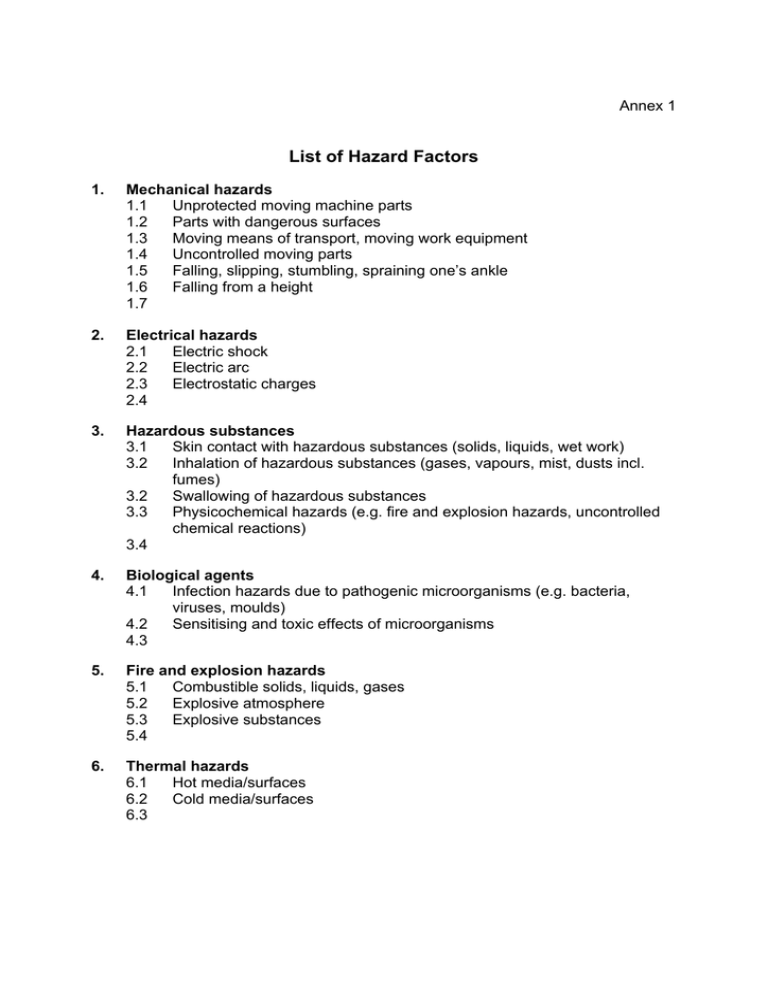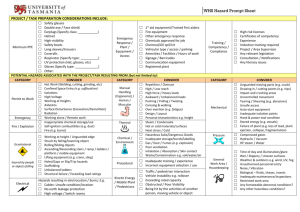List of hazard factors
advertisement

Annex 1 List of Hazard Factors 1. Mechanical hazards 1.1 Unprotected moving machine parts 1.2 Parts with dangerous surfaces 1.3 Moving means of transport, moving work equipment 1.4 Uncontrolled moving parts 1.5 Falling, slipping, stumbling, spraining one’s ankle 1.6 Falling from a height 1.7 2. Electrical hazards 2.1 Electric shock 2.2 Electric arc 2.3 Electrostatic charges 2.4 3. Hazardous substances 3.1 Skin contact with hazardous substances (solids, liquids, wet work) 3.2 Inhalation of hazardous substances (gases, vapours, mist, dusts incl. fumes) 3.2 Swallowing of hazardous substances 3.3 Physicochemical hazards (e.g. fire and explosion hazards, uncontrolled chemical reactions) 3.4 4. Biological agents 4.1 Infection hazards due to pathogenic microorganisms (e.g. bacteria, viruses, moulds) 4.2 Sensitising and toxic effects of microorganisms 4.3 5. Fire and explosion hazards 5.1 Combustible solids, liquids, gases 5.2 Explosive atmosphere 5.3 Explosive substances 5.4 6. Thermal hazards 6.1 Hot media/surfaces 6.2 Cold media/surfaces 6.3 7. Hazard due to special physical effects 7.1 Noise 7.2 Ultrasonic, infrasonic 7.3 Whole-body vibrations 7.4 Hand-arm vibrations 7.5 Non-ionising radiation (e.g. infrared radiation (IR), ultraviolet radiation (UV), laser radiation) 7.6 Ionising radiation (e.g. X-rays, gamma rays, particle radiation (alpha, beta and neutron radiation)) 7.7 Electromagnetic fields 7.8 Vacuum or gauge pressure 7.9 8. Hazards due to ambient working conditions 8.1 Climate (e.g. heat, cold, inadequate ventilation) 8.2 Lighting, light 8.3 Suffocation (e.g. due to oxygen-reduced atmosphere), drowning 8.4 Inadequate escape and transport routes, inadequate safety and health protection labelling 8.5 Inadequate area of movement at the workplace, unfavourable arrangement of the workplace, inadequate break and sanitary rooms 8.6 9. Physical load / work intensity 9.1 Heavy, dynamic work (e.g. manual handling of loads) 9.2 One-sided, dynamic work, body movement (e.g. frequently repeated movements) 9.3 Posture work (constraint posture), holding work 9.4 Combination of static and dynamic work 10. Mental factors 10.1 Inadequately designed tasks (e.g. predominantly routine tasks, overqualification and underqualification) 10.2 Inadequately designed work organisation (e.g. work performed under great pressure of time, changing and/or long working hours, frequent night work, working sequence not thought through) 10.3 Inadequately designed social conditions (e.g. lack of social contacts, unfavourable leadership style, conflicts) 10.4 Inadequately designed workplace and ambient working conditions (e.g. noise, climate, confined space, inadequate perception of signals and process features, inadequate software design) 10.5 11. Other hazards 11.1 due to people (e.g. assault) 11.2 due to animals (e.g. getting bitten) 11.3 due to plants and vegetable products (e.g. sensitising and toxic effects) 11.4


